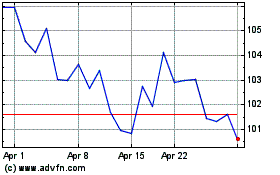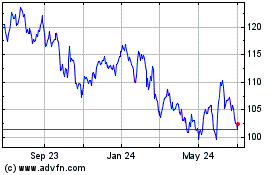Sales growth slows on slack demand as food maker turns to
healthier fare
By Brian Blackstone and Saabira Chaudhuri
This article is being republished as part of our daily
reproduction of WSJ.com articles that also appeared in the U.S.
print edition of The Wall Street Journal (February 16, 2018).
Sluggish U.S. demand held Nestlé SA to its slowest sales growth
in decades last year, underscoring the challenge facing the Swiss
company as it tries to recast itself as a nimble provider of
healthy food and drinks.
The results for 2017, which missed analyst estimates despite a
raft of measures to jump-start growth, ratchet up the pressure on
Chief Executive Mark Schneider. The former health-care executive
has faced calls from activist investor Daniel Loeb to raise
shareholder returns since soon after he took the reins at Nestlé at
the start of last year.
In the U.S., Nestlé's largest market, the Nescafe and Purina
owner has struggled to woo shoppers or raise prices despite an
improving economy.
Since Mr. Loeb took a $3.5 billion stake in the world's biggest
packaged-foods maker, Mr. Schneider has moved to sell Nestlé's U.S.
confectionery business, set a formal margin target and begin
remaking about 10% of its portfolio. The company has made a string
of acquisitions of high-growth businesses, including Blue Bottle
coffee, vitamins maker Atrium Innovations and meal-delivery service
Freshly. It also launched a big share-buyback program.
Despite such efforts, results for 2017 were disappointing.
Organic growth, which strips out the effects of currency changes,
acquisitions and divestments, measured 2.4%. That was below last
year's pace of 3.2% and the weakest since at least the mid-1990s
when Nestlé started tracking that indicator. Analysts had expected
2.6% growth.
Sales were weak at the end of 2017 when the global economy
seemed to be perking up, sparking fears about Nestlé's prospects
for the new year.
Nestlé shares fell 2.1% on Thursday in Switzerland.
"Mark Schneider's efforts to shift the group's focus toward a
better balance between margin expansion and top-line growth are
welcome, yet significant structural headwinds persist," said
Liberum analyst Robert Waldschmidt.
Nestlé's total sales were 89.8 billion Swiss francs ($96.9
billion), up 0.4% from 2016 and roughly in line with analyst
estimates. Net profit was 7.2 billion francs, down nearly 16% and
well below expectations.
The lackluster results could heighten pressure on Nestlé to take
more dramatic steps to improve its financial performance. Mr. Loeb,
who runs the hedge fund Third Point LLC, has called for Nestlé to
sell its 23.29% stake in L'Oréal SA, saying the money could be used
to buy back shares.
On Thursday, Nestlé said it remains committed to L'Oréal
although it won't increase its stake. It is considering selling its
Gerber Life Insurance business, which it inherited as part of its
acquisition of Gerber from Novartis in 2007, The unit had sales of
840 million francs last year.
In an interview, Mr. Schneider said he thinks the various steps
Nestlé is taking to increase sales -- including making careful
acquisitions and restructuring its skin-health business -- will pay
off over time. He said consumer sentiment in the U.S. appears to be
improving and that inflation is picking up, both factors that could
help Nestlé this year.
"I'm very convinced the path we're on is the right one. This is
where today's consumer is going and we are catering to that," said
Mr. Schneider. "We will explain that to our investors including
Third Point."
Like rivals Nestlé has struggled with rising competition from
local upstarts and a rapid shift in consumer tastes toward locally
grown, organic food and away from mass-produced prepared meals that
have long been a staple for the maker of Stouffer's frozen dishes
and Lean Cuisine.
Mr. Schneider aims to move Nestlé's portfolio away from the more
mainstream food and drinks that are facing fierce competition from
private label brands and toward healthy, specialized products for
which people are willing to pay a premium. Nestlé will continue to
make acquisitions but will mainly focus on tweaking existing brands
to make them healthier and more upscale.
"We will not solve the situation simply by drinking the ocean
dry, by buying small to mid-sized companies and enjoying their
growth," Mr. Schneider said. "We would end up with an ungovernable
group of companies and that would be like herding cats."
Nestlé, like some of its consumer-goods peers, has struggled to
charge more for its products, with prices for 2017 edging up just
0.8%. Procter & Gamble Co., Kimberly Clark Corp. and
Colgate-Palmolive have reported weak sales as traditional retailers
like Walmart Inc. push for steep discounts as they compete with
Amazon.com Inc., even as input costs rise. P&G, the maker of
Tide detergent and Pampers diapers, last month said that average
prices on its products fell on a quarterly basis for the first time
since 2011.
Among food companies, Nestlé's pricing was on the low end. "Our
pricing is clearly on the weaker side when compared to other
leading competitors," said Mr. Schneider. "We have some catching up
to do."
Write to Brian Blackstone at brian.blackstone@wsj.com and
Saabira Chaudhuri at saabira.chaudhuri@wsj.com
(END) Dow Jones Newswires
February 16, 2018 02:47 ET (07:47 GMT)
Copyright (c) 2018 Dow Jones & Company, Inc.
Nestle (PK) (USOTC:NSRGY)
Historical Stock Chart
From Mar 2024 to Apr 2024

Nestle (PK) (USOTC:NSRGY)
Historical Stock Chart
From Apr 2023 to Apr 2024
